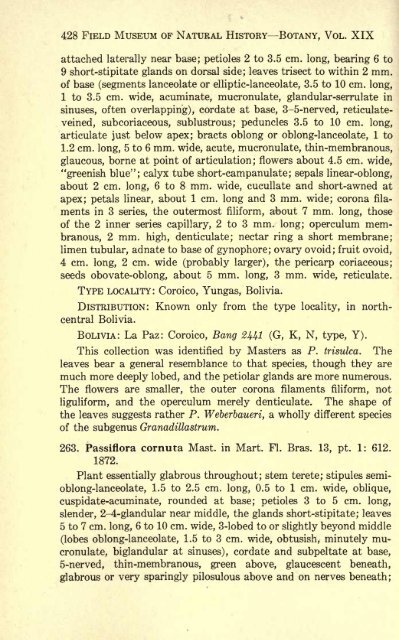downloads/Killip 2.pdf - Passion Flowers
downloads/Killip 2.pdf - Passion Flowers
downloads/Killip 2.pdf - Passion Flowers
You also want an ePaper? Increase the reach of your titles
YUMPU automatically turns print PDFs into web optimized ePapers that Google loves.
428 FIELD MUSEUM OF NATURAL HISTORY BOTANY, VOL. XIX<br />
attached laterally near base; petioles 2 to 3.5 cm. long, bearing 6 to<br />
9 short-stipitate glands on dorsal side; leaves trisect to within 2 mm.<br />
of base (segments lanceolate or elliptic-lanceolate, 3.5 to 10 cm. long,<br />
1 to 3.5 cm. wide, acuminate, mucronulate, glandular-serrulate in<br />
sinuses,<br />
often overlapping), cordate at base, 3-5-nerved, reticulateveined,<br />
sub coriaceous, sublustrous; peduncles 3.5 to 10 cm. long,<br />
articulate just below apex; bracts oblong or oblong-lanceolate, 1 to<br />
1.2 cm. long, 5 to 6 mm. wide, acute, mucronulate, thin-membranous,<br />
glaucous, borne at point of articulation; flowers about 4.5 cm. wide,<br />
"greenish blue"; calyx tube short-campanulate; sepals linear-oblong,<br />
about 2 cm. long, 6 to 8 mm. wide, cucullate and short-awned at<br />
apex; petals linear,<br />
about 1 cm. long and 3 mm. wide; corona filaments<br />
in 3 series, the outermost filiform, about 7 mm. long, those<br />
of the 2 inner series capillary, 2 to 3 mm. long; operculum membranous,<br />
2 mm. high, denticulate; nectar ring a short membrane;<br />
limen tubular, adnate to base of gynophore; ovary ovoid; fruit ovoid,<br />
4 cm. long, 2 cm. wide (probably larger), the pericarp coriaceous;<br />
seeds obovate-oblong, about 5 mm. long, 3 mm. wide, reticulate.<br />
TYPE LOCALITY: Coroico, Yungas, Bolivia.<br />
DISTRIBUTION: Known only from the type locality, in northcentral<br />
Bolivia.<br />
BOLIVIA: La Paz: Coroico, Bang 2441<br />
(G, K, N, type, Y).<br />
This collection was identified by Masters as P. trisuka. The<br />
leaves bear a general resemblance to that species, though they are<br />
much more deeply lobed, and the petiolar glands are more numerous.<br />
The flowers are smaller, the outer corona filaments filiform, not<br />
liguliform, and the operculum merely denticulate. The shape of<br />
the leaves suggests rather P. Weberbaueri, a wholly different species<br />
of the subgenus Granadillastrum.<br />
263. Passiflora cornuta Mast, in Mart. Fl. Bras. 13, pt. 1: 612.<br />
1872.<br />
Plant essentially glabrous throughout; stem terete; stipules semioblong-lanceolate,<br />
1.5 to 2.5 cm. long, 0.5 to 1 cm. wide, oblique,<br />
cuspidate-acuminate, rounded at base; petioles 3 to 5 cm. long,<br />
slender, 2-4-glandular near middle, the glands short-stipitate; leaves<br />
5 to 7 cm. long, 6 to 10 cm. wide, 3-lobed to or slightly beyond middle<br />
(lobes oblong-lanceolate, 1.5 to 3 cm. wide, obtusish, minutely mucronulate,<br />
biglandular at sinuses), cordate and subpeltate at base,<br />
5-nerved, thin-membranous, green above, glaucescent beneath,<br />
glabrous or very sparingly pilosulous above and on nerves beneath;
















